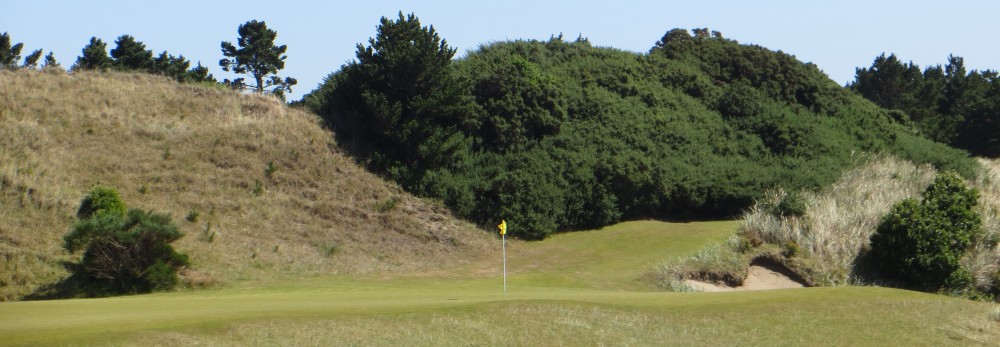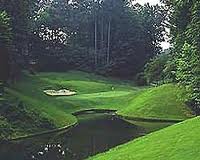 Spring Creek Golf Course was created to support a high end housing community about seventeen miles east of Charlottesville. When it came on line the economic infarction of the time seems to have upset real estate sales, yet this course has design quality and integrity that should make it a success as a fee course until that trend turns around. Ed Carton has considerable deputy experience with Tom Fazio and it shows in the presentation of this course. Like his mentor this course is visually pleasing and seems to fit into the regional topography very comfortably. The course has won some instant national recognition by the national golf magazines and has been favorably compared in reviews to the other jewel of Virginia, Lester George’s very private Kinloch Golf Club outside of Richmond. The difference is this place is totally accessible to the fee paying public.
Spring Creek Golf Course was created to support a high end housing community about seventeen miles east of Charlottesville. When it came on line the economic infarction of the time seems to have upset real estate sales, yet this course has design quality and integrity that should make it a success as a fee course until that trend turns around. Ed Carton has considerable deputy experience with Tom Fazio and it shows in the presentation of this course. Like his mentor this course is visually pleasing and seems to fit into the regional topography very comfortably. The course has won some instant national recognition by the national golf magazines and has been favorably compared in reviews to the other jewel of Virginia, Lester George’s very private Kinloch Golf Club outside of Richmond. The difference is this place is totally accessible to the fee paying public.
For a residential community course this has a modern design characteristic rarely seen in these type of developments-generous hole setbacks from the residential lots. The owner, Charles Kincannon, showed great discipline in allowing the design team to employ such setbacks which make the holes seem very comfortable in their surroundings without visual encroachment. Given the dramatic topography on which this course is built that has resulted in holes of stunning visual stature as well as tactical uniqueness.
The most obvious characteristic is the generous use of sand throughout the course. This is an expensive design decision but, as you see on Fazio style courses, free form expansive bunkering is a visual accent that can be psychologically intimidating and provide tactical parameters that challenge the golfers as well. My wife said on about the eighth hole, there must have been no sand left in Virginia Beach once this course opened for play. Most interesting is that she played the entire 18 holes and was not in a single bunker-now that is good design.
Another unique characteristic for this region is the choice of bent grass for the fairways and tees. Zoysia and Bermuda grasses are usually the choice when you get this far South but the bent works well and it displays beautifully when it is well maintained and manicured as it is out here. There is also the clever use of indigenous rock accenting some of the low creeks, crossing bridges, and the high areas behind some greens. Given the severity of the topography this stone softens many of the visual transitions that were required.
The greens themselves may be the most unique part of this design. They are vast, sprawling green surfaces with lots of facet and undulations. The speed on these greens, especially down the slopes, can be disarming. You need to play this course a number of times to understand the tactical requirement of your approach positions into these greens. On many holes the greens have fall offs in more than one direction or insidious little donut depressions that feed to side pitching areas. Knowing how to negotiate these and leave yourself an uphill putt you can play aggressively is the secret to scoring well. The pro told me before I played that the yardage on the card belies the difficulty that the rating and slope indicates. The need to be able to approach these greens with a club you can control is critical so pick your tee length conservatively if you want to enjoy your day.
The front side starts with a wonderful challenging par four that will set the tone that ball control and accuracy are at a premium. The next two holes, a very technical par five and a seemingly innocuous par four that is in fact the first handicap hole will serve to reiterate that notion. From four to nine, with the exception of a bear of a challenge on six, the yardage will not overwhelm you but don’t be lulled into a sense of security, good planning and articulate shot execution will be rewarded.
Once you turn to the inward nine the adrenaline rush will begin on the tenth tee. This is an old classic style 90 degree dogleg right which means it is all about position off the tee followed by an aggressive uphill carry shot into a well guarded green. The next three holes are very interesting technical holes that present your best scoring opportunity run of the day. On the fourteenth tee you will witness the anti-gravitational moment of being atop of the highest point of your favorite thrill ride. Other than a reprieve on the short par three seventeenth from this point it is just one G-force experience after another that will exhaust your strength and test your resolve all the way to the house. The eighteenth hole, a wild and wooly par five that is a hooker’s nightmare, is one of the most difficult holes you can face if you need a par to close out a match. Just a terrific exclamation point for a course that has no shortage of thrills and spills.
If I have any criticism it is the array of par threes. All four of them play within one club of each other so the yardage demand on the short holes does not vary much at all. The four par threes are of distinct characters but they are probably the least interesting offerings of the day for me.
What sets this course apart for me is that, for an architect without a vast resume of his own courses to fall back on, Barton has succeeded in putting together 18 wonderful holes that work well together. You would think in such an early effort there would be at least two or three holes that either did not fit in or just did not work. Cannot say that about this place, every hole seems to fit the motif and there is not a single hole out there that will fail to stimulate your aesthetic and athletic sensibilities. This place may seem out of the way but it is well worth the effort to seek it out and play it more than once.
Gordonsville, Virginia
Architect: Ed Carton (2006)
Tees Par Yardage Rating Slope
Marble 72 6673 73.2 145
Onyx 72 6197 70.9 138
(Click here to review Spring Creek hole-by-hole descriptions)






























